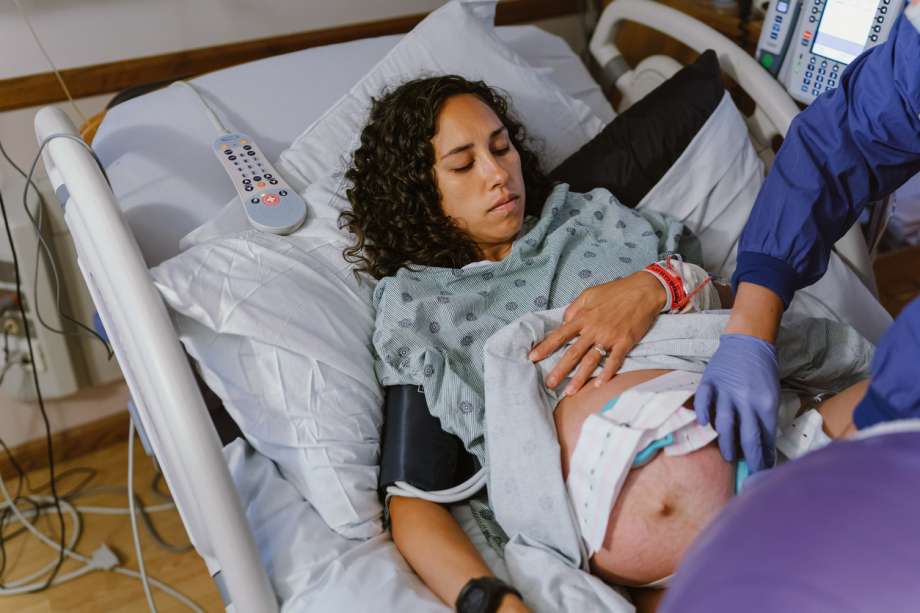Is Pitocin Safe to Induce Labor?

In most pregnancies, nature tells the body when it’s time to deliver a baby. But in some cases, nature may need a little help. Pitocin is a medication that’s used to induce labor.
Why might your doctor want to induce? And is Pitocin a safe way to do it?
Related: 10 Completely Natural Ways to Induce Labor
What is Pitocin and How Is It Used During Childbirth?
Pitocin is a synthetic version of Oxytocin, a hormone that everyone’s body produces.
Some have called Oxytocin “the love hormone,” because it helps us to bond with loved ones—not just parents and children, but romantic partners and others as well (Harvard Health, 2023). Oxytocin helps us to recognize our loved ones and promotes feelings of love and trust (Cleveland Clinic, 2022).
During childbirth, Oxytocin makes the uterus contract, which helps the body to deliver a baby. Pressure on the cervix from contractions makes the brain produce more Oxytocin, which produces even more and stronger contractions until the baby is delivered.
In cases where labor hasn’t started yet, Pitocin may be used to stimulate uterine contractions and start the cycle.
How is Pitocin Administered?
First, your doctor will examine your cervix. If your cervix is ready for labor, it will soften, open, and rotate to the front to let your baby emerge. If your cervix isn’t ready, however, it will be closed, thick, and high (Brusie, 2023).
If your cervix isn’t ready yet, your doctor has various methods of promoting cervical ripening and dilation, including medication, natural techniques, and special devices.
Once your cervix is ready, then your body is ready to receive the Pitocin.
Pitocin is usually delivered through a controlled intravenous drip.
Why Would You Need to Induce Labor?
There are many reasons your healthcare provider may recommend inducing labor. Here are some of the more common ones.
Delayed Labor
When pregnancy goes beyond 41 weeks and six days, it poses risks to both mother and child.
Amniotic fluid levels may become low, which can affect the baby’s heart rate and umbilical cord. The baby may also grow large enough to pose a risk to the mother during delivery. And babies past 42 weeks of gestation are at greater risk of aspirating meconium (their first bowel movement).
For these reasons, if you’re two or more weeks beyond your due date, your doctor may want to speed things along.
Your medical team may also want to induce if your waters have broken but labor hasn’t started.
Avoiding Cesarean Delivery (C-Sections)
A cesarean delivery or C-section is major surgery, and that comes with major risks and a long recovery period. If your body is having trouble starting labor, inducing it with medication can reduce your chances of having to have a Cesarean section.
Specific Health Conditions
Your doctor may also want to induce labor in the case of certain health conditions that pose a risk to you, your child, or both. These include:
- Gestational diabetes
- Hypertension disorders such as preeclampsia, chronic high blood pressure, or gestation hypertension
- Kidney disease
Risks of Pitocin Use

Pitocin use for induction of labor has a number of risks and side effects that can affect both mother and child. These are some of the more important potential side effects of induction with Pitocin.
Overstimulation of the Uterus
Pitocin stimulates the uterus to contract. When the uterus contracts, the blood flow and oxygen supply from the placenta stop for the duration of the contraction. After the contraction, the placenta returns to a resting state, and both blood and oxygen flow again.
Hyperstimulation of the uterus can result in stronger and more frequent contractions. If the contractions are too strong, too frequent, or go on for too long, there may not be enough rest between them for the placenta to provide your baby with fresh blood and oxygen. (Mayo Clinic, 2022).
This can result in a birth injury, including different types of brain damage (Drugs.com, 2022).
Uterine Rupture
For mothers who have had a C-section with a previous pregnancy, hyperstimulation of the uterus can result in a ruptured uterus. This happens when the uterus tears along the scar line of the previous C-section.
In the case of a rupture, a new C-section may be required. The uterus may also have to be removed altogether (Mayo Clinic, 2022).
Infection
A uterus rupture during the process of labor increases the risk of infection for both mother and child.
Drop in Fetal Heart Rate
The temporary slowing or stopping of oxygen and blood flow from the placenta can result in a drop in the baby’s heart rate (Mayo Clinic, 2022). A low heart rate can affect the flow of blood and oxygen to your baby’s brain (WebMD, 2023).
Cerebral Palsy
Cerebral Palsy is a lifelong, incurable condition that affects a person’s ability to control their muscles. It’s caused by damage to or abnormal development of the baby’s brain.
Some issues that can occur as a result of uterine hyperstimulation can lead to a baby developing Cerebral Palsy. These include lack of oxygen during the birth process, infection (from a uterine rupture), placenta detachment, and umbilical cord problems (CDC, 2022).
Fetal Distress
“Fetal distress” is a condition in which a baby is showing signs of distress during labor. Often it’s caused by inadequate oxygen. Overstimulation of the uterus from Pitocin use can result in fetal distress.
Fetal Death
Overstimulation of the uterus, one of the possible side effects of pitocin, can result in fetal death from a number of causes.
Postpartum Risks
Hyperstimulation of the uterus can result in an increased risk of postpartum hemorrhage for the mother.
In addition, the use of Pitocin has been associated with a lower APGAR score (Drugs.com, 2022).
The APGAR test is a series of observations by the OB-GYN just after birth. APGAR is an acronym for Appearance (skin color), Pulse, Grimace response (reflexes), Activity (muscle tone), and Respiration.
A low APGAR score means a baby is more likely to need emergency medical care following birth.
Testing for Possible Allergic Reactions to Pitocin
Allergies to Oxytocin (and therefore Pitocin) are rare, but they do exist. What’s more, if you have a latex allergy, you may have an increased risk of synthetic Oxytocin allergy (Liccardi et ali., 2013).
If you’re concerned about possible allergic reactions to Pitocin, ask your medical team about testing.
Pros and Cons of Using Pitocin During Labor
Obstetricians don’t use Pitocin induction lightly. If your medical team recommends it, it’s because they feel that the benefits outweigh the potential risks.
The benefits of Pitocin induction include:
- Reduction of the need for a Cesarean section
- Protection of the mother from potentially deadly conditions like preeclampsia
- Protection of the baby from the dangers of delayed labor
The risks include the potential consequences of uterine hyperstimulation, including:
- Infection
- Uterine rupture
- Fetal distress
- Neonatal brain damage
- Fetal death
Fetal monitoring during the labor process can help to prevent some of these possible side effects.
Natural Ways to Try and Induce Labor Before Pitocin

Are there other ways of inducing labor, aside from Pitocin? Yes, there are several (Marcin, 2023).
As always, it’s best to make these decisions in consultation with your healthcare provider to make sure that you’re choosing activities that are safe for your pregnancy in specific.
Walking/Light Exercise
Research has shown that walking for 30 minutes a day at a rate of 2.5 miles per hour, starting at week 38 of pregnancy, can help to induce labor. As a side benefit, it can also help to reduce the need for medical interventions during vaginal birth.
Nipple Stimulation
Stimulating your nipples with your fingers or with a breast pump can help to induce labor. It can also help to reduce the rate of postpartum hemorrhage.
Acupuncture
Using a birthing comb during labor or getting acupuncture performed by a licensed acupuncturist can increase cervical ripening, which can help your body to get ready to deliver your baby.
Seeking Advice on Pitocin from Medical Professionals
As with any medical intervention, it’s necessary to weigh the benefits against the risks. No intervention is one hundred percent safe, however in some cases, induction may be safer than allowing nature to take its course.
When in doubt, always seek medical advice from a professional, and don’t be afraid to ask your provider questions. That’s what they’re there for.

